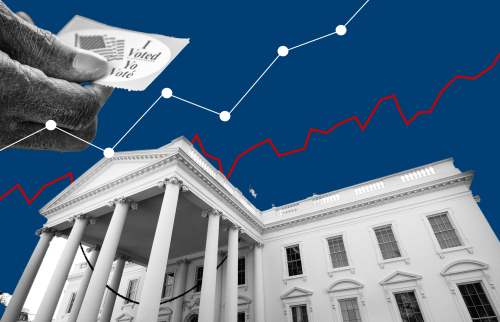In six extraordinary weeks since replacing Joe Biden as the Democratic presidential nominee, Kamala Harris has regained all the ground Biden lost between January and July—and more. She has erased the “enthusiasm gap” that separated Democrats from Republicans, topped the Republican nominee—former president Donald Trump—on key personal attributes such as honesty, and narrowed Trump’s advantage in areas of Democratic vulnerability, such as inflation and immigration.
On the face of it, the surge in popular support that Democratic presidential nominee Kamala Harris has enjoyed since President Biden withdrew from the race has moved her into the lead, not only in the national popular vote but also many of the states that have emerged as crucial in this era of close elections with historically small margins separating the parties.
Do the odds now favor Harris to win the election? Let’s dig beneath the surface to assess how she is doing.
A reader’s guide to the polls
No single public opinion survey offers an adequate basis for assessing the state of an electoral contest. Averages of multiple polls tend to minimize the impact of individual erroneous polls and locate the most probable course of public sentiment.
There are two different ways of constructing averages of multiple polls. One is simple: take all the polls on a race (national or a specific state) and determine the average of the results they report for each candidate. The other is more complicated: use standards of quality based on the prior performance of individual polling organizations as well as the sample size and timing to determine the weight that a specific poll receives. In principle, polls conducted by organizations that have been accurate in the past, use large samples, and have been released recently will receive a greater weight than those that score lower on one or more of these dimensions. A well-known example of the first, simpler method is provided by RealClearPolitics (RCP); of the second, more complex method, by FiveThirtyEight (538).
Here’s what these organizations said about the state of the race on Labor Day.
If Harris’s lead in the Blue Wall states lasts until Election Day, she will garner 270 electoral votes, even if she loses all the other swing states.
Over the past six weeks, just about everything has gone right for the Harris campaign. But because things can change, and often do, in the closing weeks of presidential campaigns, it would be hasty to conclude that Harris is now the clear favorite to win the election in November.
If her momentum continues, Harris will probably win. But it may not. If she stumbles in the September 10 debate, the momentum of the race may change. Trump’s campaign could regain its balance and sharpen its focus. And unforeseen events could shift the dynamic between the candidates.
We should also be cautious about concluding that Harris now enjoys a clear lead over Trump. In recent elections, not just individual polls but also poll averages have turned out to be misleading. Not only have there been large gaps between September surveys and actual results; the same has been true for polls conducted just days before the election. These gaps have not been random; most of them underestimated the share of the vote that Donald Trump eventually received, often by wide margins.
How the poll averages performed in recent presidential elections
Here’s a comparison of their performance in the two most recent presidential elections.
Intuitively, it would seem likely that the site using various adjustments (538) would end up being more accurate than the site providing a raw average (RCP). But the results show the opposite. In nearly every case, 538 showed a larger margin for the Democratic nominee than did RCP. And in nearly every case, the larger margin turned out to be farther from the final outcome when all the votes were tallied. The reasons for this difference are not clear.
A second systematic finding: Both the adjusted and raw averages were significantly less accurate in the Blue Wall states than in the South and Southwest. Again, the reasons for this difference are not clear. One hypothesis is that the white working-class voters who constitute the base of Trump’s coalition and dominate the electorate in the Blue Wall are unusually hard to poll, both because they are less likely to participate in surveys and because many are not regular voters and turn out only when Trump is on the ballot.
Third, differences between final averages and actual results usually have reflected underestimates of Trump’s vote share more than overestimates of support for Democratic candidates. In 2020, for example, the final 538 and RCP averages indicated that Biden would get 51.8% and 51.2% of the vote, respectively, very close to the 51.3% he actually received. But these averages also indicated that Trump would get 43.4% and 44.0%, respectively, several points below the 46.9% he ended up with. In the Blue Wall states (Michigan, Pennsylvania, and Wisconsin), 538 underestimated Trump’s vote share by an average of 4.3 points; RCP, by 2.3 points.
Is the past prologue?
Some analysts argue that poll findings from recent presidential contests have no bearing on the 2024 race: Kamala Harris is an unprecedented kind of nominee and, as one prominent optimist puts it, “Everything in American politics changed with Dobbs.”1
Perhaps it did. But if so, we would expect Harris to be doing considerably better than Joe Biden did in 2020 among the voters who are especially responsive to these considerations—young voters, minorities, and women. As of Labor Day, however, she is still doing measurably worse among some of these groups and no better than Biden with women (as shown by a comparison of recent polls averages with the 2020 results,
The impact of abortion on the 2022 midterms, when Democrats did much better than expected, is undeniable. But some evidence suggests that its impact may be more muted in this year’s contest. Yes, 12% of women consider abortion to be the most important issue in the presidential election. But twice as many—24%—say that inflation and prices take priority. As expected, the issue scores high among liberals and Democratic identifiers but much lower among groups that contain larger shares of swing voters. Only six percent of moderates and five percent of independents say that abortion is their top issue, compared to 23% and 24%, respectively, for inflation and prices.
It is possible that there will be fewer “hidden” Trump voters than there were in recent elections. But the 2022 results, when Trump was not on the ballot, do not provide evidence for this conclusion. Since 2015, the former president has forged a unique personal bond with a substantial share of the electorate. This relationship may have weakened somewhat during the past four years, but it has not evaporated. It is plausible to assume that the 2024 polls continue to understate Trump’s support, although no one can say by how much.
Hillary Clinton’s 2.1-point edge in the popular vote was not enough to yield 270 electoral votes in 2016, and Joe Biden’s 4.5 points turned out to be just barely enough. It is possible that Trump’s vote will be distributed less efficiently in 2024 if, as some surveys indicate, he gets a higher share of the vote in big blue states (such as New York) that he has no chance of winning. Even so, it seems unlikely that Harris can win with less than a three percent margin in the popular vote.
Taken as a whole, the current evidence suggests that the 2024 presidential election is likely to resemble those of 2016 and 2020. The winner’s national vote margin will be modest, and the race will be decided by a handful of votes in a few swing states. Although the outcome remains unpredictable, the contest will not be boring, and just about anything could turn out to be the decisive factor.
-
Footnotes
- Simon Rosenberg, “Hopium Chronicles,” August 31, 2024.







Commentary
Is Kamala Harris leading Donald Trump in the presidential race?
September 4, 2024